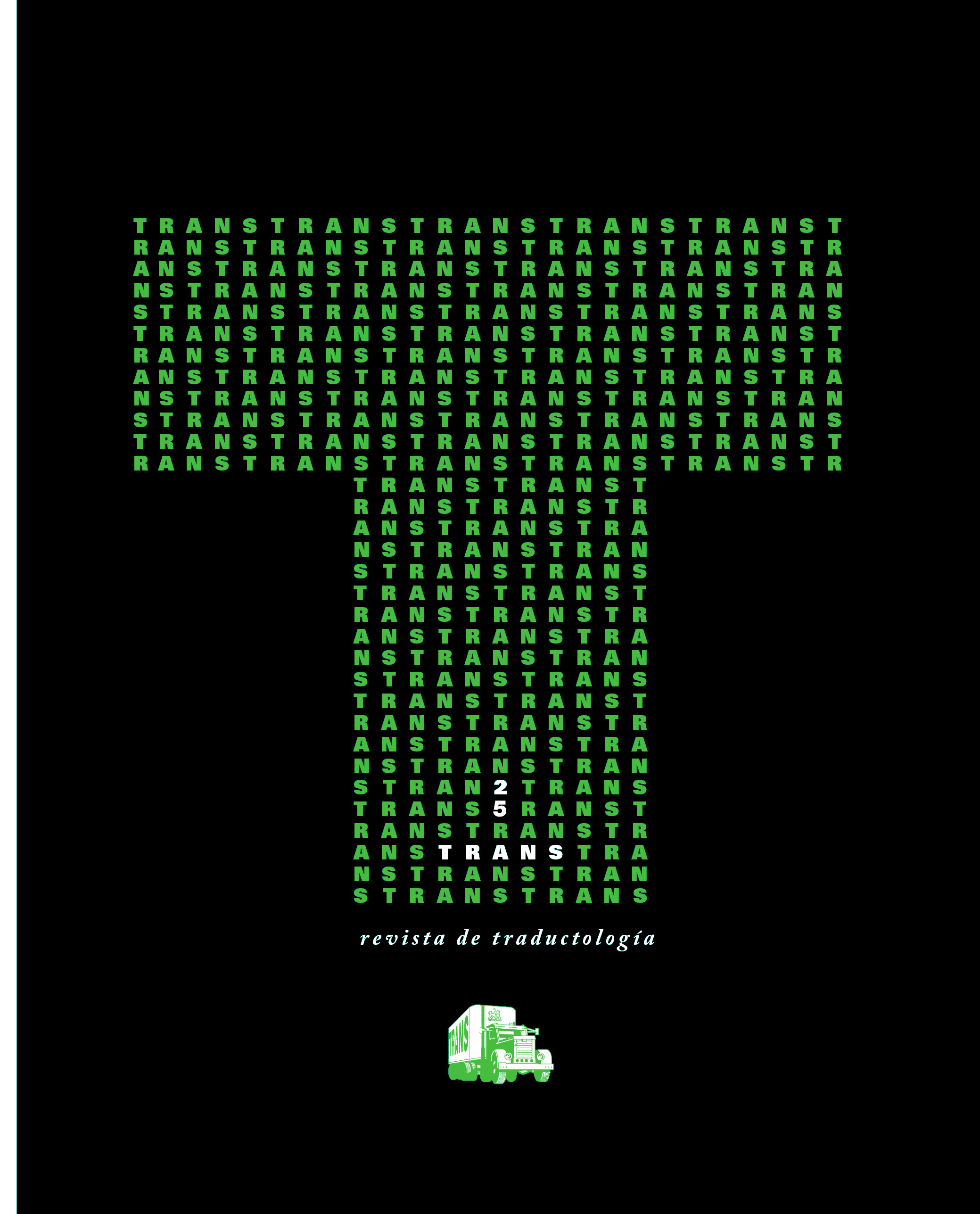An Exploration of audiovisual translation in Spain
Interviews with audiovisual translation professionals
DOI:
https://doi.org/10.24310/TRANS.2021.v1i25.12839Keywords:
audiovisual translation, labour market, fieldwork, interviewsAbstract
One of the concerns of undergraduate students in their final year of the Translation and Interpreting (TI) Degree is their career. Hence, to help clarify the doubts caused by their lack of experience in the audiovisual translation market, fieldwork was conducted in which the labour market for this TI specialization was actively explored. This article describes the experience, and presents the results obtained for the audiovisual translation market. The fieldwork involved various phases. First, the CEOs of three companies that offer audiovisual translation services, as well as seven audiovisual translators were interviewed. Then, their answers were analyzed in order to draw conclusions about the current audiovisual translation market. The information gathered from the interviews allows a panoramic view of the professional reality of the audiovisual translator and its labor market to be outlined, and it encourages future TI graduates to consider the possibility of focusing on this specialization with a more accurate and constructive insight into the profession.
Downloads
Metrics
References
AIETI (2018a): «Accesibilidad», en Enciclopedia de la Traducción Audiovisual, <https://cutt.ly/LzQ3Zja> [Consulta: 01 VI 2021].
AIETI (2018b): «Doblaje y voces superpuestas», en Enciclopedia de la Traducción Audiovisual, <https://cutt.ly/DzQ31Ae> [Consulta: 01 VI 2021].
ASOCIACIÓN ESPAÑOLA DE NORMALIZACIÓN Y CERTIFICACIÓN (2005): Audiodescripción para personas con discapacidad visual. Requisitos para la audiodescripción y elaboración de audioguías (UNE 153020:2005), Madrid: AENOR, <https://cutt.ly/HzguieH> [Consulta: 01 VI 2021].
CALVO, Elisa (2009): Análisis curricular de los estudios de traducción e interpretación en España. Perspectiva del estudiantado, Tesis doctoral, Granada: Universidad de Granada, <https://digibug.ugr.es/handle/10481/3488>, [Consulta: 01 VI 2020].
CEREZO MERCHÁN, Beatriz (2012): La didáctica de la traducción audiovisual en España: Un estudio de caso empírico-descriptivo, Tesis doctoral, Castellón: Universidad Jaume I, <https://cutt.ly/7nhT7U6> [Consulta: 01 VI 2021].
CEREZO MERCHÁN, Beatriz (2017): «La formación en Traducción Audiovisual en España: Un estudio de caso empíricodescriptivo», TRANS. Revista De Traductología, 17, 167 183, doi: 10.24310/TRANS.2013.v0i17.3234.
DÍAZ CINTAS, Jorge (2001): La traducción audiovisual: El subtitulado, Salamanca: Almar.
DÍAZ CINTAS, Jorge (2017): «Por una preparación de calidad en accesibilidad audiovisual», TRANS. Revista De Traductología, 11, 45 59, doi: 10.24310/TRANS.2007.v0i11.3097.
DÍAZ CINTAS, Jorge y Aline REMAEL (2014): Audiovisual translation: Subtitling, Londres: Routledge.
FUENTES LUQUE, Adrián (2017): «Aspectos profesionales y técnicos de la traducción audiovisual, con especial referencia al caso de España», TRANS. Revista De Traductología, 5, 143 152, doi: 10.24310/TRANS.2001.v0i5.2915.
FUNDACIÓN UNIVERSIDAD PABLO DE OLAVIDE (2017): El sector de la traducción audiovisual en España ha crecido gracias a la llegada de las plataformas digitales, <https://cutt.ly/azQZ73J> [Consulta: 01 VI 2021].
MARTÍN FERRIOL, José Luís (2006): Estudio empírico y descriptivo del método de traducción para doblaje y subtitulación, Tesis doctoral, Castellón: Universidad Jaume I, <https://cutt.ly/CnhYUKR> [Consulta: 01 VI 2021].
MAYORAL, Ricardo, Dorothy KELLY y Natividad GALLARDO (1985): Pasado, presente y futuro de la lingüística aplicada en España, Valencia: AESLA.
ORERO, Pilar, Ana María PEREIRA y Francisco UTRAY (2017): «Visión histórica de la accesibilidad en los medios en España», TRANS. Revista De Traductología, 11, 31 43, doi: 10.24310/TRANS.2007.v0i11.3096.
VALDEÓN, Roberto y África VIDAL (2019): The Routledge Handbook of Spanish Translation Studies, Londres: Routledge.
VELA VALIDO, Jennifer (2017): «La formación académica de los traductores de videojuegos en España: retos y propuestas para docentes e investigadores», TRANS. Revista De Traductología, 15, 89 102, doi: 10.24310/TRANS.2011.v0i15.3198.
Downloads
Published
How to Cite
Issue
Section
License
All contents published in TRANS. Revista de Traductología are protected under the Creative Commons Attribution-NonCommercial-ShareAlike 4.0 International (CC BY-NC-SA 4.0) license. All about this license is available in the following link: <http://creativecommons.org/licenses/by-nc-sa/4.0>
Users can copy, use, redistribute, share and exhibit publicly as long as:
- The original source and authorship of the material are cited (Journal, Publisher and URL of the work).
- It is not used for comercial purposes.
- The existence of the license and its especifications are mentioned.
- ShareAlike — If you remix, transform, or build upon the material, you must distribute your contributions under the same license as the original.
There are two sets of authors’ rights: moral and property rights. Moral rights are perpetual prerogatives, unrenounceable, not-transferable, unalienable, imprescriptible and inembargable. According to authors’ rights legislation, TRANS. Revista de Traductología recognizes and respects authors moral rights, as well as the ownership of property rights, which will be transferred to University of Malaga in open access.
The property rights are referred to the benefits that are gained by the use or the dissemination of works. TRANS. Revista de Traductología is published in an open access form and it is exclusively licenced by any means for doing or authorising distribution, dissemination, reproduction, , adaptation, translation or arrangement of works.
Authors are responsable for obtaining the necessary permission to use copyrighted images.













21.png)
